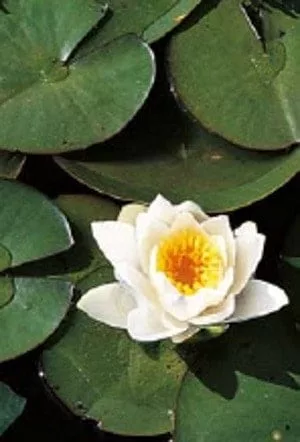Koi, an enduring and aesthetically pleasing species consisting of over 100 distinct varieties, are widely regarded as highly desirable ornamental pond fish.
Managing their fundamental needs is relatively straightforward, involving a minimum water depth of one meter and a capacity of 1,000 gallons, maintained at a temperature range of 55 to 79 degrees Fahrenheit, with a pH level of 7.5 to 8.
However, skillful consideration is necessary when selecting and introducing plant species that harmonize effectively with koi. In this discussion, we will explore the advantages of incorporating plants into your pond and identify the superior choices for koi pond environments.
Why Add Plants to a Garden Pond?
In general, the inclusion of plants in a pond offers numerous benefits irrespective of the other organisms present, fulfilling a variety of crucial functions.
Certain plant species excel at oxygenating water, while most provide essential refuge and nourishment for a diverse range of creatures, ranging from fish and frogs to birds and snails.
This enhances the biodiversity, health, and appeal of the pond. Additionally, specific plant varieties aid in the absorption of surplus nutrients like fertilizers and detrimental nitrates, thereby helping to prevent excessive algae growth.
The presence of plants also facilitates the provision of shade and contributes to the natural regulation of the pond’s temperature, all while serving as a secure surface for female koi to attach their eggs.
Across numerous regions of the world, aquatic ecosystems are facing significant challenges, including pollution, human development, and climate change, resulting in their decline.
By creating a small oasis in your own backyard, you have the potential to establish a vital stopover point for a wide range of wildlife species as they move between habitats.
This can include waterfowl, various insects (acknowledging the importance of insects), turtles, and even mammals such as hedgehogs, which simply require a water source.
If this is not your desired outcome, there are effective methods to discourage such visits, such as decoy herons or the use of netting to cover the pond during nighttime.
The Best Plants for Koi Ponds (Plants for Shelter, Oxygen & Filtration)
Acquiring plants for a koi pond can be conveniently accomplished through online platforms or local nurseries. However, determining the most suitable plant species for your fish and pond necessitates additional research due to varying requirements among different species, as well as their distinct advantages and disadvantages. Presented below are several plant species that we recommend as excellent options for koi ponds, readily obtainable for purchase in the United States, United Kingdom, and Canada.
1) Water Hyacinth (Eichhornia crassipes)
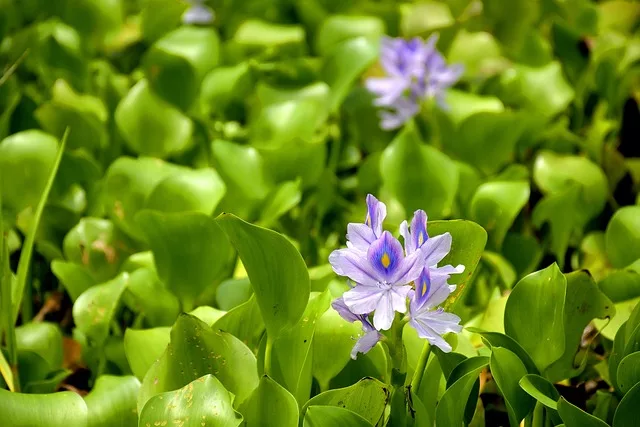
The water hyacinth, a free-floating aquatic plant, exhibits versatility in its ability to thrive in both shallow and deep waters. It is remarkably low-maintenance, adapting to various climatic conditions ranging from the northernmost regions of the United States to temperate areas near the equator.
Additionally, this plant boasts attractive purple and blue flowers that serve as an alluring spectacle for ecologically crucial pollinators such as hummingbirds and bees.
While koi fish may exhibit a propensity to consume water hyacinth, this characteristic can prove advantageous as it aids in their reproduction and widespread proliferation.
Nevertheless, without appropriate measures to address predation or regular manual removal, water hyacinth has the potential to outcompete other plant species and cause overcrowding.
As a precautionary measure, it is necessary to periodically clean the filtration system(s) to prevent blockage from residual plant matter.
2) Water Smartweed (Persicaria amphibia)
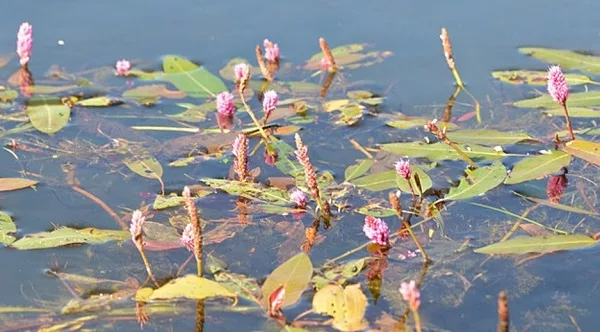
Although typically classified as a submerged plant, smartweed demonstrates a versatile growth pattern and can thrive in terrestrial environments, as long as the soil maintains a consistent moisture level. It tends to form dense colonies, reaching a height of up to 3 feet, necessitating periodic trimming to prevent excessive growth.
While some perceive smartweed as a troublesome species, it plays a crucial role in water oxygenation and serves as an exceptional water purifier. Furthermore, it serves as a valuable food source for various avian species, such as songbirds and quail, as well as macroinvertebrates.
Consequently, koi eagerly consume these macroinvertebrates, which provide them with essential protein. Throughout the period spanning early summer to mid-autumn, smartweed produces vibrant, oblong-shaped flowers.
3) Water Lotus (Nelumbo lutea)
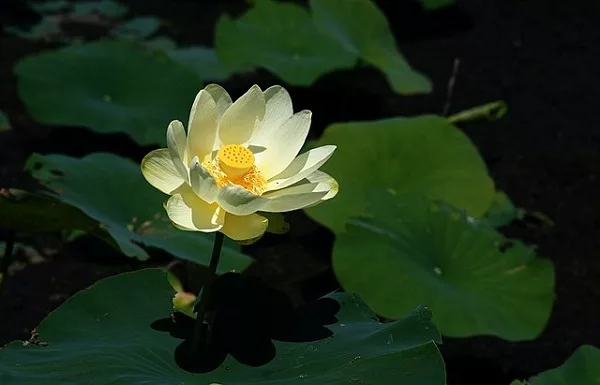
Lotuses are beautiful and popular floating aquatic plants that require little to no maintenance. However, they do have specific preferences for their growing conditions.
Ideally, lotuses thrive in water temperatures ranging from 75 to 87°F and require a minimum depth of 18 inches.
They also prefer low humidity and need at least 5 hours of direct sunlight every day. Lotuses are quite large, with some leaves reaching up to 2 feet in diameter, so they are best suited for larger koi ponds.
If you have a smaller pond, there are dwarf lotus varieties available. Additionally, lotuses are not appetizing to koi fish, and they provide shade during the hot summer months while also supporting local pollinators.
4) Water Lily (Nymphaea)
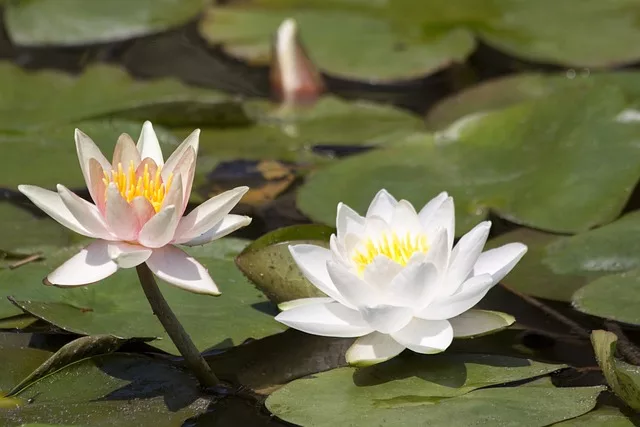
Lilies are similar to lotus plants but smaller. They can grow in cooler waters with less sunlight, making them a popular choice for koi ponds.
These floating plants can thrive in water as shallow as 6 inches or as deep as several feet. They have beautiful and fragrant flowers.
Koi fish can hide under the lily pads, lay their eggs on the undersides of the leaves, and also eat the leaves and roots.
5) Scouring Rush (Equisetum)
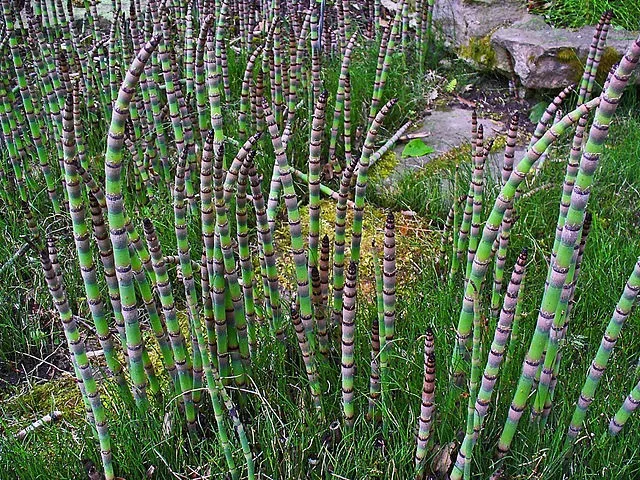
The scouring rushes are ancient plants that have been around for hundreds of millions of years.
They are the last surviving species of their kind and can be found growing along the edges of water bodies or in shallow water just a few inches deep.
A similar plant in the Equisetum genus, called horsetail, functions in much the same way. Both plants are great at filtering water and have tall segments that hold water.
These segments can be removed or grazed without harming the plant. They usually don’t take over areas or outcompete other plants, and if they become too numerous, they can be easily removed.
However, if you don’t want them to return, you’ll need to gently pull up all of the rhizomes, which are deep roots similar to cattails. Koi fish often use horsetails for shade, but they don’t usually eat them.
6) Water Lettuce (Pistia stratiotes)
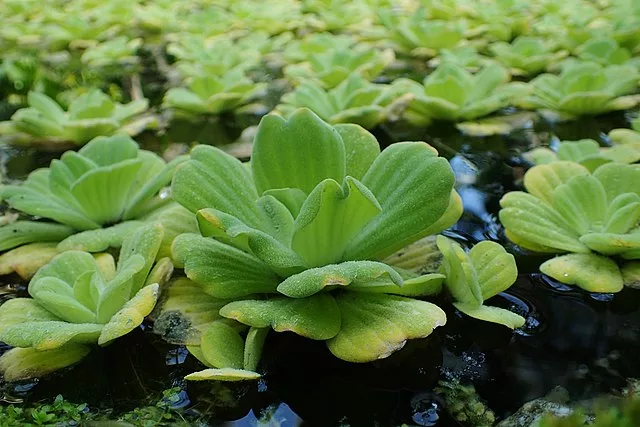
This floating plant is beneficial for your koi fish as it provides shelter, shade, and food. It naturally removes algae by filtering excess nutrients through its extensive root systems and by competing with algae for sunlight, which is necessary for algae to grow.
Water lettuce is easy to establish and maintain, and it thrives in water temperatures between 66 and 80°F.
It can be found in water as shallow as a few inches or as deep as 30 feet! Just a few of these plants can cover a large area, as a single plant can grow to be 3 feet or more. It’s so well-adapted that it can be found on every continent except Antarctica.
7) Eelgrass (Vallisneria)
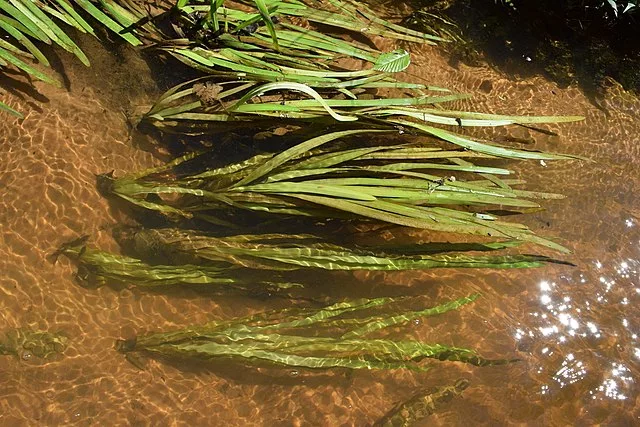
As mentioned in a previous article, eelgrass is considered one of the best plants for providing oxygen in submerged environments.
They are highly resilient and usually not damaged or eaten by koi or other large fish.
However, they can grow quite tall, so they thrive best in deeper ponds where their wavy, grass-like leaves can flourish and provide abundant habitat and shade for your koi.
Will Koi Eat My Pond Plants? (And How to Stop them)
In short, yes, it’s likely that your koi will eat your pond plants to some extent. However, they have preferences and some plants are more appealing to them than others.
As mentioned earlier, koi enjoy eating the roots of water hyacinth, water lily, and water lettuce. This can actually be a good thing because it means you won’t have to feed them as much (which is especially helpful if your koi are picky eaters or if you’re trying to save money), and it provides a natural way to control the plant population.
If you want to prevent this behavior, there are a few things you can do. You can put the plants in pots that are submerged in the water, use wire mesh to protect the roots, or place large rocks around the roots to discourage the koi from nibbling on them.
Another option is to give them extra food so they’re not as hungry and less likely to eat the plants. You can also try different types of food to find something more appealing to them than the plants. Lastly, you can choose plants that koi don’t typically eat, like waterweed, horsetail, eelgrass, and water lotus.
More informations about best plants for koi pond
free floating so more difficult to protect from nibbling koi. Water Hyacinth. Water Lettuce. Water Lily. Lotus. Water Poppy. Umbrella Plant. Water Iris. Horsetail.
Here are some of the most effective clear water plants. Oxygenating Pond Plants. Floating Pond Plants.
Variegated Water Celery. Water Iris. Water Cress. Pickerel Plant. Taro. Water Lilies.
The best plants for a koi or goldfish pond, including information on
top plant species, plant benefits, planting advice, and how to stop koi eating
Do koi ponds need plants?
Aquatic plants are considered an excellent addition to any koi pond.
Aquatic plants, in fact, help increase oxygen production in the
water, helping to keep the pond properly aerated for koi. …
The shade plants provide reduces incoming light into the pond and
thus limits photosynthesis of algae.
What plants are good for fish ponds?
Creeping Jenny Pond Plants. Often used as a ground cover in
terrestrial gardens, Creeping Jenny fares excellently when used in water gardening applications. …
Pickerel Pond Plants. …
Horsetail Pond Plants. …
Taro Pond Plants. …
Cardinal Flower. …
Water Lettuce. …
Mosaic Plant. …
Blue Irishornwort
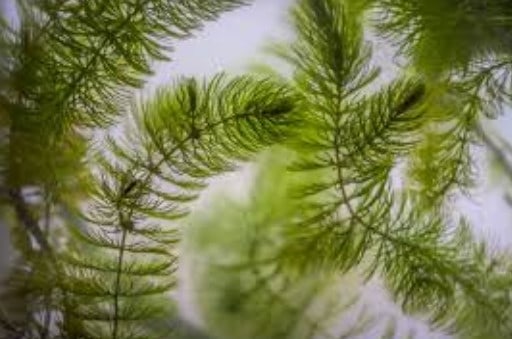
Hornwort- is a very popular submerged aquatic plant among the
aquarium enthusiasts due to their hair like foliage and hardiness.
It is also known as Coontail, cedar moss, fish blankets, horn weed,
morass weed, rigid hornwort etc.
It is native to North America but it has now a worldwide distribution due to the aquarium and pond trade.
It occurs in ponds, lakes, ditches, quiet streams and marshes with
moderate to high nutrient levels where the water bottom contains
mud, some sand or rocky materials.
It generally occupies 0.5 to 15.5m depth ranges of the water body.
It has muscular and hair-like foliage that helps oxygenate and
clarify the water as well as keep algae growth to a minimum.
lotus plant
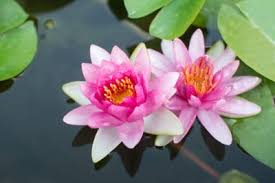
Nelumbo nucifera, also known as Indian lotus, sacred lotus, bean of
India, Egyptian bean or simply lotus, is one of two extant species of
aquatic plant in the family Nelumbonaceae. Wikipedia
Do Koi eat plants?
Plants for Koi Ponds. … This is because koi are omnivores and eat plants.
This is not so much a problem when putting koi in an established pond with many plants already in it.
But, it can be a big problem when adding a few plants to an established koi pond.
How do I make my pond water clear naturally?
Use a biological filter. A biological filter uses bacteria to remove
organic waste that can accumulate in your pond. .
..
Add barley straw to your pond. As barley straw decomposes, it
releases a chemical that prevents algae from growing. …
Add plants to the pond.
How to choose Pond plants in your garden ponds landscaping
koi pond plants As well as enhancing the look of a pond, pond plants help to maintain water

quality, providing a healthy environment for the fish.
The choice of plants will partly depend on the style of pond—a naturalistic pond looks best when heavily planted
around the edges so that it blends seamlessly into its environment, while a contemporary look may be best achieved with more minimalist planting.
A well-balanced, healthy koi pond must contain two types of plant: oxygenators , which release oxygen into the water, and floating plants , which provide shelter from sunlight.
Without these, or an efficient filtration system, the water in the koi pond can become overgrown with algae, which not only turns the water green, but can also affect the health of some fish species, such as Sterlets
Plants in the body of the pond also absorb nitrate— the product of the breakdown of fish waste—which lessens the burden on the filtration system.
Incorporating plants into a koi pond is not Incorporating plants into a koi pond is not straightforward,partly because of the depth of water, and also because koi have a habit of digging up plants and browsing on the growing shoots.
Most koi ponds, therefore, simply incorporate a few tall marginals, and perhaps some water lilies, whose leaves help to protect the fish from sunburn in the clear water.
Planting In a new pond, wait several days after filling before putting the plants in place, to allow the water temperature to rise to that of the environment.
Pot plants as necessary (see opposite), having first inspected them closely for any signs of disease or pests.
In temperate areas, spring is the best time to introduce new pond plants into an existing pond, because aquatic
plants start to grow rapidly at this time.
If the pond is large, you may need waders to put plants in place, and special pond gloves should always be worn.
These reach up to your shoulders and provide protection against waterborne diseases, such as Weil’s disease a potentially serious condition, spread by rodents, which causes jaundice.
TYPES OF KOI POND PLANTS
Plants for the pond can be divided into four categories, based on their growing habits and where in the pond they are to be found.
Oxygenating pond plants, water lilies,and floating pond plants are truly aquatic, growing in or under the water.
Marginal plants are a useful addition to the pond, not only as a decorative element,but also to provide an excellent habitat for insects.


PLANTING STYLES
The plants in and around a pond have a great effect on the overall impression created.
Traditional, formal ponds often incorporate lowgrowing plants, such as water lilies, which do not mask the crisp, neat edges of the pond.
Small ponds often benefit from the inclusion of taller, more architectural plants, such as reeds and grasses, which lift the eye, making the pond appear larger.

Three varieties of water lily (Nymphaea ‘Escarboucle’, ‘William Falconer’, and Marliacea Albida’) adorn this large, formal pond, which is bordered by the tall, elegant spikes of Iris laevigata ‘Variegata’, Canna flaccida, and Schoenoplectus lacustris.
Myriophyllum verticillatum covers one corner of the pond.
The vertical emphasis of the planting in this courtyard pond, achieved through the use of tall marginals, such as irises and rushes, enhances
the geometric lines of this modern style, while a single water lily (Nymphaea ‘Gladstoneana’) softens the look and provides cover for the fish.
Creative landscaping Edging around a pond strengthens its perimeter and helps to disguise the edge of the pond liner.
It can also prolong the life of the liner by shielding it from sunlight.
Hard construction materials, such as paving slabs or bricks, laid around the edge of a pond give a more formal look,
while natural stone or sod are ideal for a more informal pond. Another possibility is a wooden deck raised above water level,
but the wood must first be treated with a nontoxic preservative to keep it from warping or rotting.
Consider the access to the pond: if this is across a lawn, regular foot traffic can quickly result in an unsightly muddy
trail.
If you do not want to construct a path, set paving slabs into the grass as an informal solution.
The planting and landscaping around the pond can be used to disguise pond equipment. An external filter, for example,
can be hidden in vegetation in a flowerbed, although it must still be easily accessible for routine maintenance and servicing.
Moving water
A fountain is an attractive addition to any pond, and also creates a healthier environment for the fish by improving
the water’s oxygen content.
Water lilies prefer calm water, however, and will not thrive under the jet of a fountain, so they need to be located at the opposite end of the pond.
Water currents created by the fountain can waft floating plants to one side of the pond; before adding plants, test
the flow by floating a light plastic ball on the surface of the water while the koi pond fountain is operating.
If the ball drifts away from where you want the plants to be, adjust the positioning of the fountain.

Oriental-style koi ponds often incorporate bridges and decorative features of Japanese life, such as bonsai trees and
this popular style of bamboo water fountain (left). Japanese maples create a striking backdrop to the pond, and can be grown in pots or in the ground.

Reference from Encyclopedia of Aquarium and Pond Fish D Aldeton DK 2008
hardy pond plants
Hardy Pond Plants. Hornwort, Bundle of 5. 3.4. Frogbit, Bundle of 3. 4.0. Water Hyacinth, Bundle of 3. 4.3. Grower’s Choice Hardy Water Lilies. 4.2. Virginalis Hardy Water Lily. Red Stemmed Parrots Feather, Bundle of 5. Jumbo Water Hyacinth, Bundle of 3. Pickerel Rush, Bundle of 2.
best plants for koi pond frequently ask questions
Will pond plants survive winter?
No other varieties will survive the winter. After their leaves turn brown, hardy marginals (bog plants) can be trimmed back.
Never cut plants with hollow stems off below the water level,
because they will die if completely submerged (cattails, rush, and pickerel rush).
Will water lettuce survive winter?
Unless you live in a climate that doesn’t freeze, floating plants like
hyacinth and water lettuce won’t survive the winter. …
If you leave them in the pond, the dead plants will decompose and
cause water quality issues through the wintertime.
How do you overwinter tropical water lilies?
Tropical Water Lilies
Keep them actively growing by placing them in warm water with bright light and warmth.
It will be difficult to maintain a minimum water temperature of 21°C (70°F). …
Over-winter a tropical Lily by letting the tuber go dormant. Leave the plant in the pond until after a killing frost.
Do water lilies die off in winter?
Although tropical water lilies do go dormant in winter, they are
only hardy to about USDA Hardiness Zone 9.
They will freeze and die if left in a cold pond over winter. … You can move your water lilies to smaller pots for the winter, if you like. Lift the plant and trim back some of the leaves and roots
Learn more about koi pond
